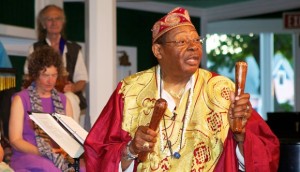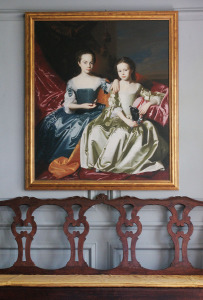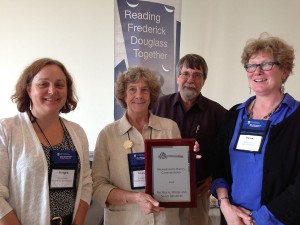Reflections on the Performance by the US Slave Song Project’s Spiritual Choir
We were delighted to host a free concert by the US Slave Song Project Inc. on the Royall House & Slave Quarters museum grounds on Sunday, August 3rd. The Spiritual Choir drew a large crowd, and the comfortably cool weather made for a lovel y afternoon.
y afternoon.
Read the Project’s two blog posts about the event, and visit their website here, as well as a commentary in the Vineyard Gazette here.
The U.S. Slave Song Project, based in Oak Bluffs on Martha’s Vineyard, is a nonprofit organization dedicated to educating the public about the authentic American folk music known as slave songs or spirituals. Under the direction of founder Jim Thomas, the chorus will perform songs that enabled enslaved African-Americans to communicate with one another, teach their children, record their history, and heal their pain.
Mary and Elizabeth Royall Return Home
 John Singleton Copley’s 1758 painting of “Mary and Elizabeth Royall” is prominently displayed in the new Art of the Americas wing at the Museum of Fine Arts, Boston. And now, thanks to a multi-faceted community partnership, a large, high-quality reproduction of Copley’s portrait of the adolescent daughters of Isaac Royall is on display in the Royall House, as well. In a very generous example of nonprofit partnership, the Museum of Fine Arts offered our museum an archival replica of the painting at cost. The Medford Arts Council– a local agency which is supported by the Massachusetts Cultural Council, a state agency– awarded a grant to enable us to make this purchase. An anonymous private foundation’s grant paid to frame the reproduction, a task that was undertaken with great professionalism by Stanhope Framers.
John Singleton Copley’s 1758 painting of “Mary and Elizabeth Royall” is prominently displayed in the new Art of the Americas wing at the Museum of Fine Arts, Boston. And now, thanks to a multi-faceted community partnership, a large, high-quality reproduction of Copley’s portrait of the adolescent daughters of Isaac Royall is on display in the Royall House, as well. In a very generous example of nonprofit partnership, the Museum of Fine Arts offered our museum an archival replica of the painting at cost. The Medford Arts Council– a local agency which is supported by the Massachusetts Cultural Council, a state agency– awarded a grant to enable us to make this purchase. An anonymous private foundation’s grant paid to frame the reproduction, a task that was undertaken with great professionalism by Stanhope Framers.
Copley was just twenty years old when he completed this work, one of his few paintings of children, and believed to be his first double portrait. According to the portrait’s description by the MFA, “Royall’s love for fine things is evident in the portrait he commissioned of his daughters, which was designed to show off the family’s wealth and social status: the girls are dressed in expensive silk gowns trimmed with imported lace, and the velvet drape behind them was intended to bring to mind portraits of English aristocrats who had themselves painted in such a setting. Even the pets in the picture conveyed status: the King Charles spaniel was a favorite of British royalty, and the hummingbird perched on Mary’s finger may have been imported from the West Indies, where Royall conducted profitable trade. The obedient pets and the girls’ modest demeanor were also meant to indicate the girls’ character, showing them to be polite, disciplined, well-mannered young women– good daughters and good future wives.”
A Conversation with Board Member Jennifer Pustz and Textile Artist Ifé Franklin
On Wednesday, Oct. 23 at 7 p.m., Spoke Gallery hosted a conversation with Ifé Franklin and Jennifer Pustz, member of the board of the Royall House & Slave Quarters. For her solo exhibition entitled Indigo Project, textile artist Ifé Franklin has created an 8-foot slave cabin in patchwork adire (“tie and dye”) at Medicine Wheel’s Spoke Gallery in South Boston. To learn more about about Ms. Franklin and the exhibition, read the full Boston Globe article.
Cummings Foundation Grant Supports Elementary School Programs
 We are very excited to announce that the Royall House and Slave Quarters is a 2013 recipient of a Cummings Foundation $100K for 100 grant. The grant will support in-depth educational field trips at the museum for elementary school students, which will be focused on northern colonial slavery, the economics of the slave trade, and the lives of enslaved Africans in the Massachusetts colony.
We are very excited to announce that the Royall House and Slave Quarters is a 2013 recipient of a Cummings Foundation $100K for 100 grant. The grant will support in-depth educational field trips at the museum for elementary school students, which will be focused on northern colonial slavery, the economics of the slave trade, and the lives of enslaved Africans in the Massachusetts colony.
 Educational resources will include the museum’s buildings, household items, artifacts unearthed on site, and a rich collection of relevant primary source documents. The first year’s allocation will address preservation, accessibility, and sustainability issues in the Slave Quarters meeting room, which will be used as classroom space for the school programs. Three subsequent years’ funding will support program implementation, including educational staff and transportation subsidies to ensure that students from low-income school districts have access to this important American history. We are deeply grateful to Cummings Foundation and the Cummings family for their confidence in our organization.
Educational resources will include the museum’s buildings, household items, artifacts unearthed on site, and a rich collection of relevant primary source documents. The first year’s allocation will address preservation, accessibility, and sustainability issues in the Slave Quarters meeting room, which will be used as classroom space for the school programs. Three subsequent years’ funding will support program implementation, including educational staff and transportation subsidies to ensure that students from low-income school districts have access to this important American history. We are deeply grateful to Cummings Foundation and the Cummings family for their confidence in our organization.
Royall House and Slave Quarters Honored by Mass Humanities
On Monday, June 3, Mass Humanities presented the Royall House and Slave Quarters with the 2013 Massachusetts History Commendation at its annual Mass History Conference. This award recognizes groups or individuals who do outstanding work to make history more relevant and meaningful to the people of Massachusetts. Explaining why the organization was chosen for recognition, Pleun Bouricius, assistant director of Mass Humanities, said, “During the past decade, the Royall House and Slave Quarters has acted upon the recognition that its concrete and physical connection to the local history of enslavement of African-Americans needed to be brought to the fore. The organization committed itself to historical honesty, wrote grant proposals and researched its history, collaborated on extensive archaeology work, and created and implemented a plan to adjust its identity as a historic site. With the help of dedicated volunteers, the Royall House and Slave Quarters is emerging as a leader in its field in Massachusetts, and an example to other organizations with small purses and large plans.” Past recipients of the Commendation include State Representative Byron Rushing and the Historical Journal of Massachusetts. The award further strengthens the relationship between the Royall House and Slave Quarters and Mass Humanities. Over the past several years, Mass Humanities has awarded several grants to the museum to support its work. These have included funding to develop on-site school programs, research into the correspondence of the Royall family, and the launch of a new website to better tell the museum’s story.
with the 2013 Massachusetts History Commendation at its annual Mass History Conference. This award recognizes groups or individuals who do outstanding work to make history more relevant and meaningful to the people of Massachusetts. Explaining why the organization was chosen for recognition, Pleun Bouricius, assistant director of Mass Humanities, said, “During the past decade, the Royall House and Slave Quarters has acted upon the recognition that its concrete and physical connection to the local history of enslavement of African-Americans needed to be brought to the fore. The organization committed itself to historical honesty, wrote grant proposals and researched its history, collaborated on extensive archaeology work, and created and implemented a plan to adjust its identity as a historic site. With the help of dedicated volunteers, the Royall House and Slave Quarters is emerging as a leader in its field in Massachusetts, and an example to other organizations with small purses and large plans.” Past recipients of the Commendation include State Representative Byron Rushing and the Historical Journal of Massachusetts. The award further strengthens the relationship between the Royall House and Slave Quarters and Mass Humanities. Over the past several years, Mass Humanities has awarded several grants to the museum to support its work. These have included funding to develop on-site school programs, research into the correspondence of the Royall family, and the launch of a new website to better tell the museum’s story.
